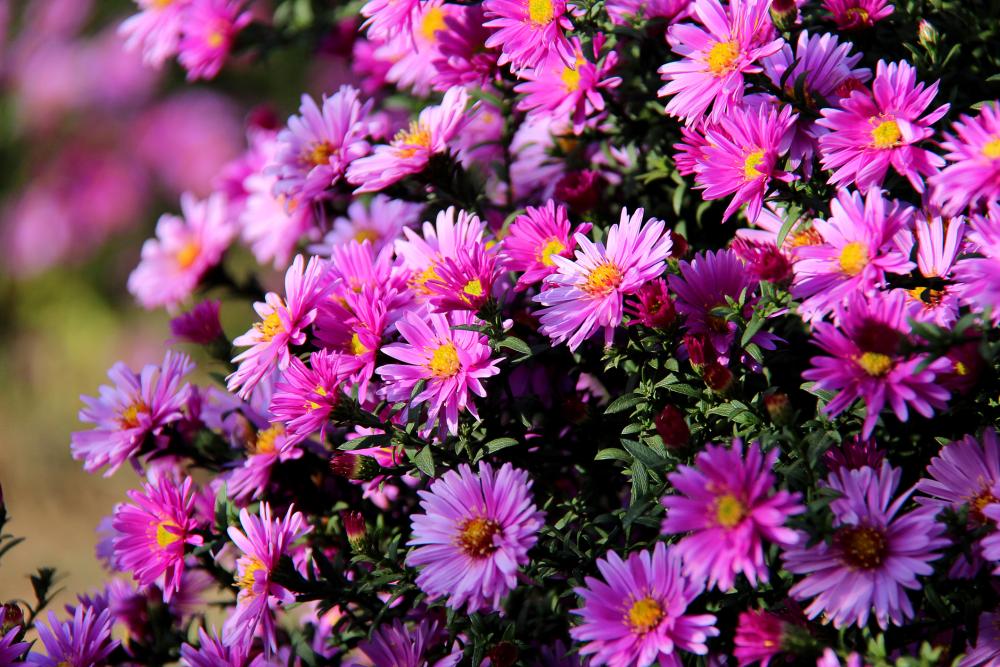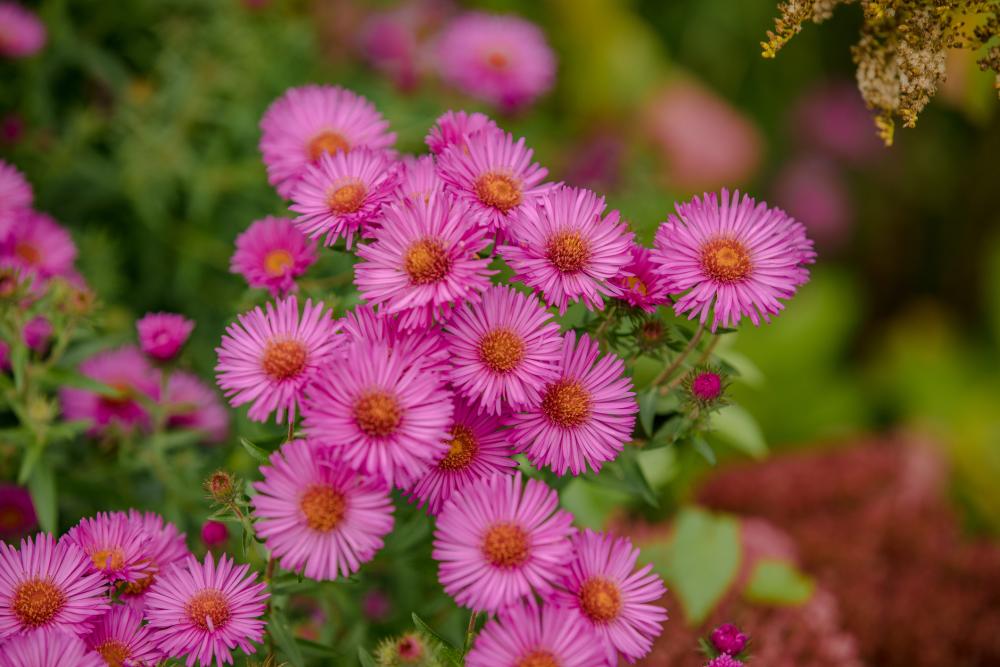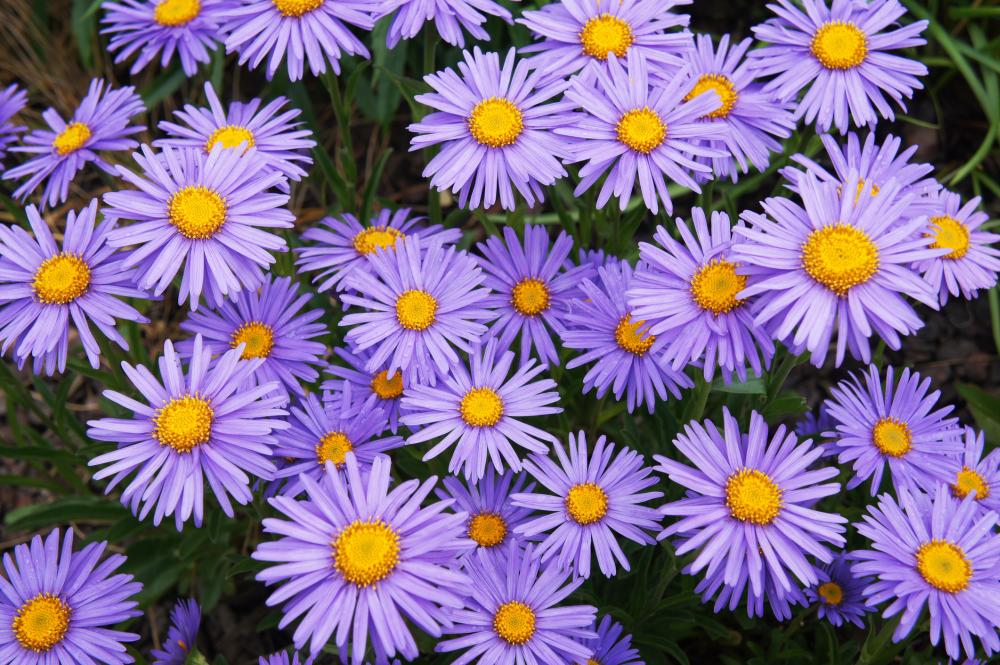Asters Care - How To Grow And Care For Asters
Asters are like daisies on steroids. Not merely because they're prettier, but also considering they come in different varieties and types. So much and then that it would take an gorging gardener a long time to go through all the asters bachelor in nature.

Since diverseness is the spice of life, asters in your garden bring joy and vitality that few floral plants can manage. And like clockwork, it blooms every twelvemonth without fail. So y'all tin start your floral arrangements from mid-summertime all the manner to early fall. And did nosotros mention it was piece of cake to abound and maintain? Read on to find out more about asters, how to found them, care for them, and apply them to design your landscape and home.
All About Asters
Asters refer to a genus of plants that encompass over 250 species and countless more cultivars and hybrids. They're commonly grown for their ornamental values since they have a long flower time that starts from Baronial until September. Some cultivars bloom earlier than that and last longer.
About aster species grow well between zones 3 to 10. Even so, some cultivars are more than adjusted to absurd atmospheric condition and tin thrive and bloom even in partial shade. As a native of North America, these plants are adapted to almost hardiness zones and abound well in the wild.
There's no boilerplate height for asters. Each species varies wildly from the next. The majority of asters will abound betwixt 1 to iii feet. But some dwarfish types will non grow above 5 or 6 inches. This will come in handy when you lot're designing a landscape with asters, as we'll encounter below.
The same can be said about colors. The flowers blossom in a myriad of colors depending on the species or cultivar. The well-nigh ascendant asters colors are purple, white, cherry-red, bluish, and pink.
Simply asters are not just all about blooms. They have foliage that competes for your attention. About varieties have nighttime greenish leaves and long slender stems. The stems are normally smooth, so they're easy to option and conform.
Design with Asters

With such a wide variety of sizes and colors, asters are a designer's ultimate dream. You can mix and match blooms of different colors, plant the tall varieties as an impressive backdrop, and use the modest species as ground embrace. Asters offering y'all a seemingly countless array of designing options express only by your imagination. Here are some designing tips to get you started.
- Institute asters of different heights to create a stunning landscape. The 6-human foot tall varieties become in the back and encompass walls and fences. The shrubs create a colorful ground cover. In between, found medium-summit cultivars.
- Selection the correct species for the right spot. Some varieties such as Symphyotrichum cordifolium, Symphyotrichum ericoides, and Symphyotrichum novi-belgii are dominicus-loving and will flourish under the full sun. Others prefer fractional shade and have a loftier tolerance for dry out soil. So there's always the right aster for your particular landscape.
- Asters thrive in large groups. So don't limit yourself to a few plants when you lot can fill up a whole corner with different species. Just make sure the cultivars all bloom at the same time to enjoy a spectacular view of cascading colors.
- Asters are good container plants as well. For containers, use a bushy cultivar that fills up the pot and overflows with shimmering night green foliage. A unmarried aster is enough per container.
- Plant asters as companion plants to bulbs and bushes that likewise bloom in the late summer and early on autumn. Xanthous and purple asters go well with other perennials since they complement a lot of different colors without stealing the show.
- Another option is to establish asters with other companion plants of contrasting colors. Foliage bushes, for instance are a wonderful backdrop for strategically placed asters with vivid and cheerful colors.
- Landscapers don't recommend mixing asters with daisies. They'll compete and look like an odd couple in your garden.
How to Grow Asters
Another aspect of asters that endear them to gardeners is that in that location are many ways to institute them. Y'all can showtime them from seeds, use cuttings, or grow the mature plants by division. Each method has its advantages, although if you're planting a cultivar, you should use a cutting over seeds. Seeds of cultivars don't always produce the same constitute you had in listen.
- Start the seeds indoors virtually 4 weeks later on the terminal frost.
- Fill a shallow tray with a general-purpose potting mix.
- Sow the seeds near a quarter-inch deep and space them one inch apart.
- Embrace the seeds with a shallow layer since they need light to germinate.
- Sprinkle enough water to become the potting mix all moist without soaking it.
- Place the tray in a sunny spot sheltered from cold winds and drafts.
- When the seedlings are virtually 3 inches loftier, thin them out and leave a healthy seedling every 3 inches.
- Harden the seedlings gradually by taking them outdoors for a few hours every twenty-four hours.
- Set up the soil in the garden choosing the right sunday exposure that suits that particular aster species or cultivar.
- Amend the soil to make it loose and well-drained. If you have loamy soil, then you don't need anything apart from some organic materials to brand information technology richer.
- Turn upwardly the top 10 inches of the soil and let it balance in the dominicus. This cures the soil of any lurking pathogens and improves aeration.
- Dig a pigsty the same depth as the root ball of the seedlings and a little wider than its diameter.
- Moisten the potting mix in the tray to brand information technology easier to excerpt each seedling.
- Ease the seedling in the hole so that the soil line on the stem aligns with the edge of the hole.
- Backfill the pigsty with soil and business firm it gently to chase out any pocket holes.
- Space the seedlings according to the cultivar. If in doubt, keep them 26 inches apart unless y'all're growing the small species every bit footing cover.
- Water the soil to become it moist, then comprehend it with a thin layer of mulch.
If you lot're growing a cut instead of seeds, cut a half dozen-inch stem and remove the leaves at the bottom. Dip the cutting in rooting hormone pulverisation, then plant information technology in a container filled with soil. Water it regularly to keep it moist and place it in a sunny spot. When new growth emerges, you can transplant the sapling to the garden following steps 9 to 15.
Asters Care

Asters, in general, don't need much intendance. There's no surprise at that place since they're hard perennials that suit well to different types of soil and weather conditions. However, some pruning would be required from time to time, peculiarly with the aster cultivars that go leggy. And if yous allow asters to reseed themselves, the new plant might not wait anything similar their parents. Also, they might not flower.
Soil
While asters are not very particular about the blazon of soil you plant them in, you lot should avert clay and sandy soil. Heavy soil retains water which is not what the plants prefer. And sandy soil loses moisture faster than the roots tin absorb it. Better the soil to make it as close to loamy equally possible. The soil pH should be either neutral or a little acidic. Go a reading of the soil structure before sowing the seeds and improve it to become the reading between v.5 and 6.five.
H2o
As with many perennials that you grow in the garden, asters will need about one inch of h2o a week. You can interruption up this corporeality according to the soil type and flavor. In the summer, you might have to water the asters every day. The same is true for loose soil that dries upward too fast. Focus on the base of the plant and give information technology enough water to brand the soil moist. Few asters can tolerate dry soil. Once the flowering season is over, you can cut dorsum on watering and allow the top couple of inches of soil to become dry between irrigations.
Lite
The low-cal requirements of asters vary depending on the species and cultivar. While virtually natural species relish the sunlight, some tin tolerate fractional shade. That said, y'all should protect the plants from the glaring afternoon sun in hot zones. In those cases, the morning sun should be enough for the flowering asters. Place them in a spot facing the north or east. In absurd zones, plant the asters in the garden where they confront the w or south to get equally many hours of sunlight equally possible.
Fertilizer
Don't allow the hardy asters with a reputation for growing only about anywhere fool you. These perennials demand every bit much feeding as any other plant. So before planting them in the soil, mix in a good portion of aged manure or other organic materials. This has the advantage of increasing the acidity of the soil in example information technology's as well alkaline. Once the plants are growing, side-dress them with phosphorus-rich fertilizer and apply slow-release organic compost during the growing season. Hold off all types of feeding once the last flower has dropped. Don't fertilize during the fall or winter to avoid triggering new shoots that will perish in the cold weather.
Pruning
Pruning and deadheading of asters go mitt in hand. Especially if you take a bushy aster or 1 that gets leggy. Fifty-fifty if the plant behaves well and doesn't have up more space in your garden than necessary, you still need to trim off a broken or damaged stem here and at that place. Deadheading the flowers is important to prevent the aster from reseeding. As for gangling plants, yous can encourage them to grow more than robust and bushy by snapping the tip off the master stems early in the spring. Lateral stems hateful well-distributed blooms all over the constitute and non just at the summit.
Pests and Diseases
Existence hardy doesn't protect asters from the onslaught of many pests. Aster leafhoppers, aphids, tarsonemid mites, snails, and slugs frequently attack the plant and feed on the leaves, stems, and flowers. While it's common to get rid of aphids by hosing them off the plant with a strong h2o stream, you shouldn't practise that with asters. Information technology could trigger a fungal infection. Instead, spray the infected plants with neem oil to kill the small pests. As for snails and slugs, you can pick them past hand and drown them in soapy water. Don't release the pests exterior the garden, as they will certainly clamber back.
The well-nigh mutual diseases that asters suffer from are white smut, foliage spots, powdery mildew, and rust. Y'all should keep the garden clean and remove weeds to get rid of pests that carry pathogens. Also, continue the asters well-spaced and improve air circulation to prevent fungal breakouts.
Source: https://www.diys.com/asters-care/
0 Response to "Asters Care - How To Grow And Care For Asters"
Postar um comentário